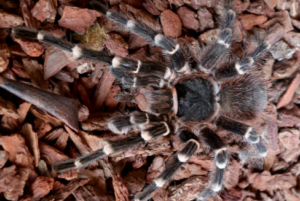The Acanthoscurria geniculata is very stunning, with its huge size and the vivid markings on its legs. These leg markings act as a warning coloration for these species so predators will leave it alone.

The giant white knee tarantula is a good display tarantula because they don’t spin too many webs in their enclosures, and they are often visible since they seldom dig burrows as adults. This is why the A. geniculata is very famous in the arachnid keeping hobby. In the Philippines, this species is often displayed in pet exhibits to attract people; this way, more of them can appreciate arachnids, especially children, as they don’t look as scary as the stereotypical horror movie spider.
An unusual—yet itchy—defense
Usually docile and defensive rather than aggressive—contrary to popular belief that they are an aggressive species—the A. geniculata seldom attempt to bite. Instead, they flick their urticating hairs and stands their ground when threatened. Urticating hairs are tiny barbed hairs that New World tarantulas such as the Brazilian Giant White Knee can flick towards a perceived attacker. These can cause severe itching and irritation, or even serious allergic reactions when inhaled or touched; these can also cause serious damage if too many enter the eyes or lungs. Urticating hairs are attached to a tarantula’s abdomen. Should you notice that the tarantula uses these hairs too much, it means that it is being subjected to too much stress in its environment or enclosure. However this is not something to worry about in terms of aesthetics; if your pet Brazilian Giant White Knee Tarantula has a bald spot due to too much flicking of urticating hairs, all of it can be regrown in the next molt. Just make sure that your pet tarantula is not subjected to too much stress such as handling or uneaten live feeders running around its terrarium.

Another reason for popularity
In the tarantula keeping hobby, the Brazilian white knee bird-eater became famous worldwide beginning in 1998. It was especially sought by people who believed that “bigger is better” when it came to their pets, since this species is a member of the “bird-eater” group of tarantulas in the invertebrates keeping hobby.
It earned the name “bird-eater” after people observed how these tarantulas tackled and ate live birds, both in captivity and in the wild. Because of the massive size and strength of the bird-eater tarantulas, they are able take down prey bigger than themselves; even if the prey struggles, it will still have a hard time escaping the fangs of the bird-eater tarantulas, as these can reach up to an inch in length. The venom injected by these bird-eating tarantulas also plays a role since they can inject more venom than smaller species of tarantulas. This enables them to devour prey such as birds, which can be fast; but since tarantulas are often ambush predators, they wait until it is the right time to strike to ensure a kill.
The Brazilian White knee Bird-eater grows fast but starts out small. Spiderlings of this species are only about half a centimeter in size during their first feeding stage after they hatch from their eggs. Despite their small size, they have a huge appetite for prey that is the same size or a bit bigger. As spiderlings, they molt more often, so they grow quickly. This molting process only slows down when they have reached their maximum size; for females, this is around 7-8” of their diagonal leg span. Once this size is reached, the female tarantula will only molt once a year or every 16 months.

However, when males reach their ultimate molt, they will already have hooks in their first pair of legs; thus, they will no longer grow or molt again. In rare cases that a mature male molts again, it is always unsuccessful and leads to death due to a bad molt. The size of mature males depends on the size of their enclosure.
For intermediate keepers
The Brazilian White knee bird-eater is recommended for intermediate tarantula keepers because of their defensive nature, since beginners in the exotic pet keeping hobby often like to attempt to handle their pets. It is possible with this species, though not recommended, because sometimes these animals are unpredictable.
Though the venom of the A. geniculata is not very potent, the bite force and their huge fangs can cause mechanical damage such as deep puncture wounds or large scratches from their huge fangs. Also, their urticating hairs cause more irritation in human skin than those of the other “beginner tarantula” species, such as the Brachypelma sp. This is probably due to the size of their urticating hairs, which have barbs; in this, they differ from urticating hairs of other New World tarantula species.
The A. geniculata is nice to look at and very entertaining to feed, which makes them a must-have for every invertebrate hobbyist.
This story appeared in Animal Scene’s August 2015 issue.






